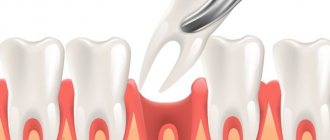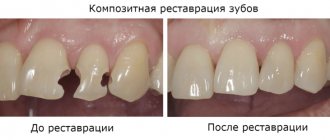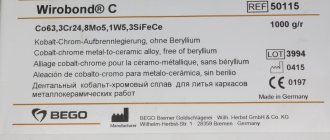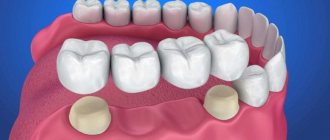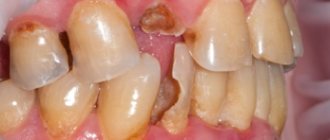As you know, most species of sharks completely change their teeth several times during their lives, and some of these dangerous predators manage to do this every few weeks. A person lives with one “set” all his life. At the same time, poor ecology, poor oral hygiene, unhealthy food, caries and other dental diseases do their job - they destroy our teeth. Fortunately, modern dentistry has a whole arsenal of tools for their restoration. Which ones exactly - says the chief physician, therapist and esthetician of the AktivStom clinic in Moscow, Yana Valentinovna Fedorova.
Teeth extension methods
Modern dentistry offers various methods and technologies for teeth extension. The choice of method depends on the patient’s financial capabilities and indications. Repairing a badly broken tooth will require such a drastic decision as installing a crown. A small chip can be corrected using composite materials. If a tooth has lost around 10–20% of tissue, then this is an indication for the installation of indirect ceramic veneers (provided that the patient does not suffer from tooth wear).
Need for expansion
The question of the advisability of this operation can hardly be classified as controversial. With the exception of a number of contraindications (which will be discussed a little later in the corresponding section of this review), the decision to grow teeth turns out to be truly correct from both an aesthetic and functional point of view.
The technology currently used allows for prompt and high-quality restoration of worn teeth, as well as completely eliminating the consequences of chipping. And if for the rear, hidden from prying eyes, units of the dentition, the main parameters are reliability and practicality, then the front row, which is in plain sight, should also have excellent presentability. Fortunately, today all these problems are completely solvable.
For the restoration of primarily molars, a composite material is often used, which in its physical, safe and aesthetic properties is as close as possible to the natural original. As a result of the restoration, the incisors and molars are completely restored to their original natural shape and color.
Teeth extension using composite materials
Modern filling materials used for the restoration of front teeth harden only under the influence of the rays of a special lamp, most often an ultraviolet one. This gives the specialist the opportunity to carefully restore the natural shape of the damaged tooth. This is especially important when reconstructing large chips. However, after curing, the composite material becomes no less durable than a natural tooth, and if the doctor follows all standards and protocols, the junction of the enamel and the composite will not only be invisible, but also reliable - the tooth restored in this way will last for many years. However, it should be remembered that such restorations still have a service life and after 7 to 10 years they may require replacement.
Preparing to restore teeth using extensions
- Make an appointment with a dentist to decide on an option for restoring a tooth or several teeth.
- The specialist uses a composite scale to determine the natural shade of your teeth and select the required color for a filling or crown.
- It is imperative to do an X-ray examination of the roots and canals of the teeth to exclude pathological processes and, if necessary, prescribe treatment.
- If you want to achieve impeccable aesthetics, before adding teeth, the remaining teeth are whitened, and the color and transparency of the new tooth (which is being restored) is matched to the rest.
- If you have dental caries or gum disease, they must be treated. Only treated and thoroughly examined dental units can be restored!
- Preventive teeth cleaning and removal of hard and soft plaque are performed.
How is front teeth augmentation done?
The front teeth are quite often subject to mechanical damage - chips and cracks form on them, and as a result of injuries, a significant part of the tooth can even break off. Also, the front teeth are susceptible to wear; if the problem is aggravated by a direct bite, then the wear becomes pathological. A special type of wear on the front incisors is horseshoe-shaped, which is often found among those who like to chew seeds. In addition, a common problem is gaps between the front teeth. In most such cases, functionality and aesthetics can be restored with the help of tooth augmentation with composite materials.
Another way to correct teeth in the smile area is to build teeth using veneers. These are thin plates attached to the front surface of the teeth. They perfectly imitate natural enamel in color and transparency, and do not add excessive thickness to the teeth. Veneers can be composite (made by a doctor directly in the patient’s mouth) and ceramic (made in a dental laboratory and glued to the teeth using special cement). This method of restoration is suitable in cases of thinning enamel, microcracks, and small chips. Also, extensions using ceramic and composite veneers help get rid of gaps between teeth - diastemas and threes, in cases where you can do without orthodontic treatment.
Basic methods
There are several methods of teeth extension, differing in technology, compositions used, and price. The main methods include:
- Filling.
- Installation of veneers.
- Installation of crowns.
- Extension on a pin.
Each method has its advantages and disadvantages, which are discussed below.
Sealing
Filling is one of the simplest and most affordable ways to build up a tooth, provided that the bone tissue is preserved. The dentist selects a shade of the composite that is as close as possible to the patient’s natural enamel color. Then the composition is applied layer by layer to the dental unit, resulting in the formation of a monolithic structure with a tooth. The filling hardens under the influence of light - it quickly gains strength and practically does not wear out over time. The top layer is sanded and varnished, due to which it most accurately replicates the natural relief of dental tissue.
The main advantages of filling:
- Nerve preservation.
- Possibility of restoration of both minor defects and severe damage.
- High speed of the procedure - you can restore a tooth in one visit to the dentist.
The disadvantages include the fact that the aesthetics of the restored tooth directly depends on the skill of the dentist, who must give it the most natural shape possible. There is almost always a risk that the filling will look less natural than the “native” hard tissue of the unit.
Installation of veneers
Another way to build up your teeth is to install veneers. They are thin porcelain microprostheses that imitate the front surface of a tooth. Overlays allow you to hide discoloration, signs of enamel destruction, chips and make your smile attractive.
The service life of the plates is 10-15 years, during which they do not change color even with frequent consumption of coloring products (berries, wine, coffee). But dental porcelain can crack under high loads and direct impacts.
Before installing the veneer, the tooth is prepared - the top layer of enamel is removed. Then a plate is applied and fixed with dental cement. This extension technology is used to restore only the front teeth. Among the main advantages of the technique are:
- High aesthetics.
- Long service life of structures.
The disadvantages include the need to remove the top layer of enamel. This can be avoided by installing lumineers - even thinner microprostheses that are fixed directly to the tooth surface without preliminary preparation (grinding).
Installation of crowns
Crowns are metal, ceramic or metal-ceramic caps that imitate the surface of one or more dental units. Installing crowns allows you to compensate for serious defects - for example, chips or the complete absence of several teeth, and restore beauty and functionality to your dentition.
The denture is made in a dental laboratory using a previously taken impression, so it fits the patient perfectly. Before tooth augmentation, the oral cavity is sanitized, nerves are removed, and the units on which the crown will be placed are turned. The procedure requires multiple visits to the dentist.
Modern crowns made of ceramics and metal-ceramics restore aesthetics to the smile. The material imitates the shade of enamel, does not absorb food coloring, and does not wear out during use. The service life of crowns depends on the manufacturing technology and averages 10 years or more. The main advantages of this extension technique:
- Possibility of restoration of both anterior and chewing teeth.
- Restoration of dental units with partial or complete edentia.
- Highly aesthetic results.
Among the disadvantages is the fairly high cost of the procedure. However, the price can be reduced by using more affordable materials in the crown manufacturing process.
Extension on a pin
Extension on a pin or pinning is recommended by the dentist if the hard tissues of the tooth are destroyed, but the root is not damaged. During the procedure, a rod is screwed into the jaw, onto which a temporary crown is placed.
After the surrounding tissue has healed, the temporary crown is replaced with a permanent one. Advantages of this extension method:
- Possibility of restoration of both front and back teeth.
- A wide variety of post materials allows the patient to influence the cost of the restoration towards its reduction.
- Long implant lifespan.
The disadvantages usually include the need to restore tissue after implantation of the rod, during which a person experiences some discomfort (inflammation and swelling of the gums). Another disadvantage is the relatively high price of pin extensions.
Teeth extension with photopolymer
Another feature of composite materials that should not be forgotten is the degree of porosity, which exceeds the porosity of natural enamel. For the patient, this means two things: firstly, in the first few days after augmenting the front teeth with composite materials, you should refrain from consuming coloring foods and drinks, and every six months, when visiting a professional hygiene procedure, you need to pay special attention to the restorations, including the hygienist should polish them thoroughly. As for the external difference between the augmented areas of teeth and natural ones, thanks to modern methods for producing composites, the dentist has the opportunity to choose the color of the restoration to match the color of the patient’s enamel.
In what cases is extension applied?
Despite the fact that tooth tissues have high density and strength, they can be destroyed for various reasons.
Firstly, pulpless teeth are often subject to destruction. Once the nerves are removed, they are no longer supplied with nutrition, their tissues demineralize and become fragile. Fragments can break off from the edges or chewing surface, and subsequently the teeth can become significantly damaged.
Secondly, teeth can be severely damaged from sports or household trauma, from chewing or biting off very hard food. In such cases, small chips of the edges, chewing surfaces, and cracks are common [2]. Children's front teeth often suffer due to accidental injuries.
In these cases, tooth augmentation helps restore the lost part of a broken tooth, in which the missing fragments are molded by a specialist from a composite material [2]. Front teeth augmentation is also successfully used in pediatric dentistry, where, thanks to modern materials and methods, pediatric specialists are able to restore a damaged tooth, which reliably serves the little patient until it is replaced with a permanent one.
Some dental procedures may expose the root. In this case, extensions help cover the sensitive area.
In addition, the extension procedure is also used in aesthetic dentistry to eliminate certain defects. Among them [3].
- difference due to anatomical and physiological characteristics of the shape, size, length of an individual tooth in a row;
- difference in tooth color;
- the presence of large interdental spaces;
- defects in the closure of the dentition.
Dental bonding is the most appropriate way to restore chipped teeth
“The 8 Best Ways to Improve Your Smile” American Dental Association
Extension of chewing teeth
Chewing teeth are also often subject to destruction, in most cases the cause is caries. After treatment of caries, especially deep ones, large cavities remain, which the specialist fills with filling material after treatment. However, in some cases, only the root and a few thin walls may remain from the tooth, and sometimes even these remain. However, one of the trends in modern dentistry is the use of maximally tooth-preserving techniques. Therefore, if previously a healthy root that had lost its coronal part would most likely have been removed and a bridge-like prosthesis installed instead of the tooth, or, at best, an implant, today they prefer to preserve the root and restore the coronal part by installing an inlay and a crown.
How a tooth is restored: stages of treatment
The extension procedure on a pin takes place in several stages:
- Diagnostics . Before starting the procedure, a thorough study is carried out. The patient undergoes a three-dimensional computed tomography and orthopantomogram of the jaw. It is important to consider in detail how damaged the tooth is in order to select the necessary pin and method of restoration.
- Taking impressions . To carry out restoration work, impressions are first taken. This procedure is performed if the patient has a crown installed. It is important that the crown fits anatomically into the dentition without causing discomfort to the patient.
- Bone grafting . Some patients undergo bone grafting before the augmentation procedure. This is necessary for bone deficiency.
- Installation of the pin . A pin is installed in the root. It is fixed with cement or screwed in (if the pin is active, threaded).
- Filling . The free space in the pin area is filled with composite material.
- Restoration . The final part of the procedure is when the tooth is restored. The doctor uses a durable filling material to recreate the coronal part. The restoration is carried out using a high-strength photopolymer that will last the patient up to 10 years. Now the restored part has a double support - the root and an installed pin that can withstand the loads on the tooth.
If the patient decides to undergo prosthetics, a crown is installed on the pin. Initially, a temporary crown is placed on the post. The patient stays with it until the dental technician makes a metal-ceramic crown based on the impression. The patient is then fitted with a permanent crown, secured with cement. In the future, work on polishing and correction of the permanent crown is possible.
Tooth extension onto a pin
Some dentists still carry out tooth augmentation on a pin, which involves installing a metal rod (pin) directly into the root canal and layer-by-layer application of composite materials on it. Once upon a time, this method was a real breakthrough compared to conventional filling, as it made it possible to preserve the root and completely restore the tooth, even in cases where the coronal part was completely lost. However, subsequently, caries often formed around the pin, which provoked further tooth destruction and loss. Therefore, pins are a thing of the past, giving way to more reliable methods.
What types of structures are there?
Pins differ depending on the material and type of thread. Let's look at the most popular types of structures used in dentistry:
- Anchor - made of an alloy of gold and platinum or palladium metal. There are active and passive anchor pins. In the first case, the design has a thread, in the second - without thread. The anchor pin is a rod, which is fixed in the root canal. This design provides support for both the microprosthesis and the filling. The advantage of an anchor pin is that it allows you to restore even a severely damaged tooth.
- Titanium – rod structure made of high-strength titanium alloy. This design is fixed in the root canal, often in chewing teeth, since it can withstand heavy loads. Titanium structures are suitable for bulk fillings and even prostheses.
- Fiberglass – Made from high-strength fiberglass. In terms of physical characteristics, glass fiber has similar properties to dentin tissue. Thus, when restoring with a fiberglass pin, the load on the tooth is distributed evenly. Fiberglass is used in medical practice due to its hypoallergenicity and biocompatibility. Another advantage of fiberglass is color. Such structures are colorless or resemble enamel, which is why they are also installed on the front teeth.
- Carbon fiber is the most popular type used in orthopedic dentistry. In structure and physical properties, carbon fiber structures resemble bone tissue. Such pins are characterized by both high strength and elasticity. When installing carbon fiber structures, the likelihood of root and crown fractures is minimized.
- Parapulpal - made of an alloy with stainless metal. Parapulpal structures are rarely used today. They are often installed as additional support for a filling.
Pin structures are also distinguished by shape. Based on this feature, screw, cylindrical, cylindrical-conical and conical structures are distinguished. The shape of the structure is selected depending on the structure of the root canal and the characteristics of the planned treatment.
Roll pins are used when the root strength is sufficient. They provide the patient with sufficient retention. In addition, when selecting, it is important to take into account the diameter. If the diameter of the rod is too small, then during restoration work a gap may form, which can cause the filling to become brittle and lead to infection. If the diameter is too large, there is a risk of root damage.
As for conical forms, when using such structures the risk of root damage is minimal. However, with conical pins, a wedging effect is possible during chewing.
Correction with crowns
The installation of crowns as tooth extensions is also used in cases where the tooth is not destroyed, but is sufficiently damaged. Installing a crown is one of the effective ways to restore a broken tooth, this applies to both front and chewing teeth. Crowns are also used in cases where it is not possible to fill a chewing tooth, for example, because the cavity left after caries treatment is too large. This type of permanent prosthetics, such as crowns, is an ideal solution in cases where more than 70% of the crown part of the tooth is missing.
In modern aesthetic dentistry, ceramic and metal-ceramic crowns are successfully used. The installation process itself takes place in two stages. First, the doctor prepares the tooth (removes infected tissue, grinds down the walls), then an impression is taken, from which a crown for a chewing tooth or a crown for a front tooth is made in a dental laboratory. The second stage is the fitting and installation of the finished crown. Modern ceramics, used for the manufacture of inlays and crowns, make it possible to perfectly imitate the texture, color and transparency of natural enamel, as well as select a shade in accordance with the color of neighboring teeth.
Baby teeth
Do they carry out augmentation of baby teeth? Dentists believe that the absence of one or more temporary incisors negatively affects the formation of the bite. You should not be inattentive to the issue of lack of teeth in the child’s oral cavity, since subsequently it will take a long time to correct the bite.
Important! Babies can also lose baby teeth due to injury or the development of caries, and it is the mother’s responsibility to take the child to an orthopedist for tooth reconstruction.
Restoring a lost or damaged incisor or molar is necessary for its correct replacement with a molar. In the absence of a baby tooth, the molar may grow incorrectly, because it must replace the previous tooth. If there is nothing to replace, problems may also arise with the growth of the molar.
The formation of correct articulation depends on the presence of teeth in the oral cavity. If the baby is missing several molars (or even one), problems with diction will appear.
The formation and proper functioning of the digestive system is also impossible without all the teeth. The baby may have problems chewing and digesting food. This all leads to dysbiosis and other gastrointestinal problems.
Dental augmentation for a child is a very important and necessary procedure. This is especially true for the absence of frontal incisors. The baby will speak poorly, his peers may laugh at him, and he will no longer be able to bite off an apple. Therefore, immediately take your child to an orthopedist and resolve this issue.
Dental restoration in children
For children, several methods of restoring lost teeth are used:
- inlays made of light-curing composite;
- overlay crowns made of plastic or metal.
Note! Installing overlay crowns and inlays to restore primary molars does not require preliminary grinding of the teeth.
Crowns and inlays used for children are removable and installed in a fraction of a minute. This procedure is non-traumatic and completely painless. If the onlay crown is damaged, it can be easily replaced.
Inlays are put on when a tooth is partially damaged, a crown is put on when a large part of the tooth surface is lost.
Indications and contraindications
Depending on the chosen method of teeth extension, indications and contraindications for each specific technique should be determined by your dentist. In this situation, you should not be guided solely by your taste preferences. Otherwise, your uncompromising demand: “I want veneers!” may lead to the fact that the treatment will not bring the desired effect, and the money will be wasted. Don't forget: everything is individual. For example, extensions using photopolymers are not practiced if there is severe tooth mobility. It is also recommended to avoid veneering for those patients who suffer from periodontal disease or do not have the necessary dental hygiene skills.
Main indications for extensions
- Cracks and chips
Microdamages caused by trauma. - Damage to the crown
If the dental crown is deformed or broken. - Consequences of caries
In case of advanced caries, when the tooth root is intact, but the area for filling is too large. - Gaps between teeth
Diastema, which negatively affects aesthetics. - Changing the color of the enamel A
dental defect such as fluorosis - white spots on the surface of the tooth enamel - cannot be eliminated with whitening, but can be corrected with extensions. - Increased tooth abrasion
As a result of demineralization of tooth enamel or a hereditary factor. - Malocclusion
Effective for mild defects in the occlusion of the dentition.
Absolute contraindications to extensions
- Maximum damage to the tooth
If the tooth is destroyed by more than 30%, the extension will not give a positive result. - Allergy
An allergic reaction to individual components of filling materials is rare, but its presence makes extension impossible. - Bruxism
Night and daytime teeth grinding will definitely lead to the destruction of the extended tooth. - Unsuccessful tooth localization
If the tooth is located in such a way that it cannot be isolated from saliva during the procedure, which neutralizes its result.
Make an appointment
right now!
Fedorova Yana Valentinovna
Therapist, Hygienist
Myths about tooth extensions at home
Nevertheless, on the Internet there are “professional” tips on how to grow teeth at home. Something like this: eat chalk, ground animal bones and teeth into dust. It is also recommended to rinse your mouth with an alcohol tincture of propolis and calamus root, consume more milk and fish, and add crushed chicken egg shells to your food. If you apply this whole complex, then supposedly your teeth will grow slowly, but.
If this were true, potential dental clients around the world would have long ago exclaimed: “We grow teeth at home!” Propolis, fish and milk probably won’t make your body worse. Bone meal is included in the diet of farm and domestic animals as a source of calcium. It is also used as fertilizer.
Many scientists agree that eggshells can be eaten by people with a lack of calcium in the body. The shell of chicken eggs is 90% calcium carbonate.
We will not dispute or confirm the benefits of bone meal, eggshells, milk and propolis for teeth. However, they will not help in any way to grow a tooth at home, since they do not affect human genetics. We will not discuss the obviously ridiculous advice on how to regrow your teeth yourself with the power of thought. In humans, they basically cannot regenerate.
How much does tooth augmentation cost?
If we mean tooth extension in the smile zone, then the cost of restoration with composite materials will range from 2,500 rubles to 15,000 rubles per tooth in economy and premium class clinics, respectively. The price of installing ceramic veneers starts from 20,000 per tooth in economic dentistry, and in a VIP clinic the price can reach up to 50,000 rubles per plate. The price for extension of chewing teeth consists of the cost of an inlay, a dental crown on it and the work of an orthopedic dentist, which will cost on average from 10,000 rubles to 50,000 rubles, depending on the materials used and the price segment of the clinic.
Publisher: Expert magazine about dentistry Startsmile.ru
Pros and cons of extensions
The objective advantages of artistic restoration include:
- safety (the method is suitable even for children),
- possibility of restoration even with significant chips,
- high degree of strength of the extended part,
- natural appearance.
As for the disadvantages, these include the comparative high cost. Despite the variety of methods and price categories, most often this procedure is not cheap.
Another disadvantage is that to ensure safe conditions for the restored area, it becomes necessary to wear a mouth guard during sleep.

